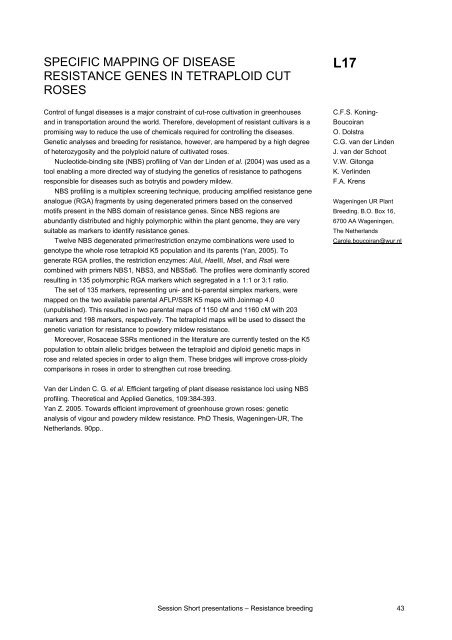XXIIIrd International Eucarpia symposium, Section Ornamentals ...
XXIIIrd International Eucarpia symposium, Section Ornamentals ...
XXIIIrd International Eucarpia symposium, Section Ornamentals ...
You also want an ePaper? Increase the reach of your titles
YUMPU automatically turns print PDFs into web optimized ePapers that Google loves.
SPECIFIC MAPPING OF DISEASE<br />
RESISTANCE GENES IN TETRAPLOID CUT<br />
ROSES<br />
Control of fungal diseases is a major constraint of cut-rose cultivation in greenhouses<br />
and in transportation around the world. Therefore, development of resistant cultivars is a<br />
promising way to reduce the use of chemicals required for controlling the diseases.<br />
Genetic analyses and breeding for resistance, however, are hampered by a high degree<br />
of heterozygosity and the polyploid nature of cultivated roses.<br />
Nucleotide-binding site (NBS) profiling of Van der Linden et al. (2004) was used as a<br />
tool enabling a more directed way of studying the genetics of resistance to pathogens<br />
responsible for diseases such as botrytis and powdery mildew.<br />
NBS profiling is a multiplex screening technique, producing amplified resistance gene<br />
analogue (RGA) fragments by using degenerated primers based on the conserved<br />
motifs present in the NBS domain of resistance genes. Since NBS regions are<br />
abundantly distributed and highly polymorphic within the plant genome, they are very<br />
suitable as markers to identify resistance genes.<br />
Twelve NBS degenerated primer/restriction enzyme combinations were used to<br />
genotype the whole rose tetraploid K5 population and its parents (Yan, 2005). To<br />
generate RGA profiles, the restriction enzymes: AluI, HaeIII, MseI, and RsaI were<br />
combined with primers NBS1, NBS3, and NBS5a6. The profiles were dominantly scored<br />
resulting in 135 polymorphic RGA markers which segregated in a 1:1 or 3:1 ratio.<br />
The set of 135 markers, representing uni- and bi-parental simplex markers, were<br />
mapped on the two available parental AFLP/SSR K5 maps with Joinmap 4.0<br />
(unpublished). This resulted in two parental maps of 1150 cM and 1160 cM with 203<br />
markers and 198 markers, respectively. The tetraploid maps will be used to dissect the<br />
genetic variation for resistance to powdery mildew resistance.<br />
Moreover, Rosaceae SSRs mentioned in the literature are currently tested on the K5<br />
population to obtain allelic bridges between the tetraploid and diploid genetic maps in<br />
rose and related species in order to align them. These bridges will improve cross-ploidy<br />
comparisons in roses in order to strengthen cut rose breeding.<br />
L17<br />
C.F.S. Koning-<br />
Boucoiran<br />
O. Dolstra<br />
C.G. van der Linden<br />
J. van der Schoot<br />
V.W. Gitonga<br />
K. Verlinden<br />
F.A. Krens<br />
Wageningen UR Plant<br />
Breeding. B.O. Box 16,<br />
6700 AA Wageningen,<br />
The Netherlands<br />
Carole.boucoiran@wur.nl<br />
Van der Linden C. G. et al. Efficient targeting of plant disease resistance loci using NBS<br />
profiling. Theoretical and Applied Genetics, 109:384-393.<br />
Yan Z. 2005. Towards efficient improvement of greenhouse grown roses: genetic<br />
analysis of vigour and powdery mildew resistance. PhD Thesis, Wageningen-UR, The<br />
Netherlands. 90pp..<br />
Session Short presentations – Resistance breeding 43














